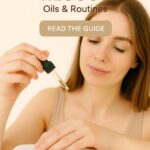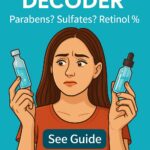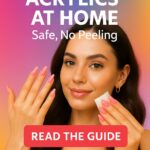
At some point in your 40s or 50s, everything starts changing at once. Hair that used to be thick feels lighter at the scalp. Skin that used to bounce now looks a little crepey on the arms and chest. Nails peel, crack, and refuse to grow. Your favorite jeans still fit, but somehow the way you feel in them is different.
This is all extremely common in perimenopause and menopause. Estrogen drops, collagen drops, moisture drops, and suddenly you are dealing with hair, face, body, and mood all at the same time.
This guide walks you through a realistic survival kit. Not just face cream. We’re talking hair density, dry skin management, nails that won’t split every time you open a soda, and confidence when your body doesn’t look like it used to no matter how “clean” you eat. We’ll also point you to deeper dives on topics like thinning edges, budget skin care for mature skin, and what actually helps crepey texture vs what is just marketing.
Why menopause changes hair, skin, and nails all at once
Your hormones are basically project managers for repair. When estrogen and progesterone fall, your body stops prioritizing things like hair fullness, plump under-eye skin, and strong nail plates. Collagen production slows. Skin barrier recovery slows. Scalp circulation shifts. The outer layer of skin also gets thinner, which is why irritation you never used to notice suddenly feels huge after a shower.
That is why so many women describe it like, “I aged five years in one year.” It’s not in your head. It’s chemistry.
The good news is you can support most of this from the outside with the right routine. You cannot fully replace estrogen by putting cream on your face, but you can reduce the look of dryness, keep hair from snapping, and help nails stay intact long enough to grow out past the weak area.
We’ll go area by area. You don’t need to overhaul your whole bathroom in one day. You just need to pick the areas that bother you most and build a plan that fits your budget. If you want a deeper breakdown of what is changing in your strands and why the texture itself can shift overnight, see Menopause and Hair Changes: Density, Texture Shift, Routine Updates on site, which goes into scalp oil changes, curl pattern changes, and why your old shampoo suddenly feels wrong.
Hair thinning, widening part, and texture changes after menopause
For a lot of women, hair is the first panic moment. You notice more hair in the drain. The ponytail wrap count jumps from two loops to three. Your part looks wider and you can kind of see scalp in bright light. On top of that, the hair you do have often feels rougher, frizzier, and more breakage prone at the ends.
Why it happens
Lower estrogen and androgen shifts can slow growth and shrink the hair follicles slightly. That means thinner individual strands. Thinner strands equal less visual volume.
What helps in real life terms
- Gentle cleansing and conditioning that doesn’t strip. Cleansing like you’re 25 can speed up breakage when you’re 48. Look for “strengthening,” “bond repair,” and “damage repair,” not just “volumizing.” Owner feedback on strengthening shampoos and conditioners is that they don’t instantly make hair thicker, but they do reduce snap at the mid-lengths, which keeps what you have on your head instead of on your shirt.
- Leave-ins and creams that add slip without grease. Products meant for frizz control and shine can double as breakage insurance now. That includes creams that smooth the cuticle so the ends don’t keep catching on sweaters and seatbelts. There is a full breakdown of that kind of smoothing in Menopause and Hair Changes: Density, Texture Shift, Routine Updates, especially for women who used to air-dry and suddenly can’t.
- Scalp-friendly styling. High tension ponytails and tight top knots can speed up thinning around the temples, which already tends to frame thinner in menopause. A lot of stylists suggest alternating where you place tension and giving hairline edges rest days.
When to worry
If you’re seeing sudden bald patches, inflammation, or itching that wasn’t there before, talk to a doctor. Gradual thinning across the top is extremely common and not a sign you did something wrong. It is also something you can style around without frying your hair flatter with high heat daily.
“Why is my skin so dry all of a sudden” and what to do about it
Another common menopause complaint: “My face and body feel tight and itchy even when I just moisturized.” You can thank barrier slowdown and collagen loss. Less collagen under the skin surface means the skin looks looser and less springy on the neck, chest, and thighs. Less oil and slower turnover means rough spots and crepey texture show more.
What helps
- Barrier style moisturizers. Think ceramides, fatty acids, and humectants, not just “anti-aging night cream.” You want something that sits on the skin and keeps water in. Our Menopause Skin Care on a Budget guide walks through which products are actually doing barrier support instead of just promising to “lift and firm” and charging luxury money for it.
- Eye area support. The eye area is often where women first see creasing jump, puffiness linger, or hollowness show. A targeted eye cream that focuses on hydration and smoothing can soften how tired you look even on bad sleep days. We have a dedicated roundup of Best Eye Creams for Wrinkles & Crow’s Feet that focuses on texture softening and brightness, not just “this has retinol so it’s anti-aging.”
- Collagen support topicals. Collagen themed creams and masks don’t rebuild collagen like you’re 22 again, but here’s what owner feedback says: skin looks more hydrated and feels more cushioned for a few hours after use, which matters when makeup keeps settling into fine lines. Our Best Collagen Face Creams and Best Collagen Face Masks pages outline which formulas give that “plump and dewy instead of tight and papery” effect and which ones are mostly marketing.
Body skin specific
That crepey texture that shows up above the knees, on the backs of the arms, and on the stomach is mostly thinning skin plus less firmness under the surface. A lot of women call it “crepe paper skin.” Smoothing, massaging, and sealing in moisture right after a shower helps more than chasing miracles. We’ll talk more about cellulite creams in the confidence section, because those tend to pull double duty on hydration and tone.
Brittle nails, peeling layers, and why they shred so easily now
There is a very specific menopause nail problem that shows up for tons of women. The top layer of the nail starts peeling off in little flakes. You finally grow past the fingertip and then the corner just splits for no reason opening a jar. You are not imagining it.
Why it happens
As hormones shift, nails often grow slower and drier. Slower growth means damage has more time to spread up the nail plate instead of being clipped off. Dryer nail plates flex and tear more easily.
What helps
- Oil, not just lotion. Nails and cuticles respond better to light oils massaged in regularly than to thick hand cream slapped on once before bed. Consistent oiling seems to be the difference between “my nails always snap” and “I can finally shape them again,” based on owner feedback collected in Brittle Nails Rescue: Oils and Routines.
- Less soaking. Long hot dishwater sessions and long showers both soften and weaken the top layers. Shorter contact with water, then sealing with oil, usually works better than thinking you need a salon strength hardener every day.
- Rounded edges instead of square corners. Square corners catch on fabric and tear. Gently rounding takes stress off the weak point while you’re rebuilding.
If you used to love acrylics or gels, you can still wear them. You just may need longer breaks between sets than you did in your 30s to let the natural nail recover under the enhancement.
“My body does not look like mine anymore” and confidence after 45
Let’s talk honestly. The hormonal shift doesn’t just hit face and hands. A lot of women see dimpling or wavy texture at the thighs, hips, lower belly, or upper arms that feels brand new. Clothes fit, but the surface of your skin in a swimsuit or fitted dress is just… different.
Cellulite is normal at every age and weight. But if it bothers you, there are two helpful angles.
Hydration and smoothing
Many so called “firming” or “cellulite” creams are basically intense hydrators with caffeine or circulation boosters. Are they a medical cure. No. But owner feedback is that a good formula can temporarily make skin look smoother, silkier, a little tighter, especially on thighs and lower belly where crepey texture shows first. We break down realistic expectations in Best Cellulite Creams and Treatments so you know what’s actually doing surface smoothing and what’s just scented lotion.
Posture and presence
You can also give yourself credit. You have lived through decades of work, kids, stress, partners, breakups, bills, sick parents, surgeries, all of it. Confidence in midlife is not pretending you are 24. It’s choosing clothes and texture and scent that make you want to show up. Perfume that makes you feel expensive on a random Tuesday. A blowout that moves instead of frizzes. A nail oil routine that makes your hands look cared for instead of tired. That stuff is not shallow. It’s morale.
Build your personal menopause survival kit
You don’t need 40 new products. You need 4 or 5 that directly solve what bugs you right now. Here’s a simple way to build your kit.
Pick one from each group:
- Hair support
A strengthening shampoo and conditioner, plus a leave-in that adds slip and shine without weighing you down. Focus on breakage control at the ends and gentle scalp care, not just “volume.” - Skin barrier support
A budget friendly moisturizer with barrier ingredients for face and neck that you will actually use morning and night. This matters more than chasing a luxury jar you “save for special,” then barely touch. Our Menopause Skin Care on a Budget guide is written exactly for that mindset. - Eye area comfort
An eye cream or eye balm that keeps the under-eye from looking sunken, papery, or angry. A bright, moisturized under-eye changes your whole face in pictures. - Nail oil
Something you keep by the sofa or nightstand and rub into cuticles and nail plates. Tiny habit, huge difference in how your hands look. - Body confidence
A firming or smoothing cream you like the feel of, not just the promise. If you hate the scent or texture, you won’t keep up with it, and these only work with consistency.
If you can get these basics in place, the rest of your routine gets way easier. Makeup applies better. Hair behaves more. Clothes feel more forgiving. You feel more like yourself walking out the door.
Final Thoughts
Menopause can feel like you’re losing control of things that used to be automatic. Hair doesn’t grow the same. Skin won’t stay smooth. Nails keep shredding. You look in the mirror and wonder when you started looking this tired.
You are not doing anything wrong. Your body is running a different program now, and that shift is normal. The goal is not to freeze yourself at 32. The goal is to support what you have so you feel put together, comfortable, and seen in your actual life right now.
Focus on moisture, barrier support, and breakage control. Build a small kit that fits your budget and your routine, not someone else’s routine from social media. And give yourself credit. Feeling good in your skin is allowed at every age.
See also
If you want a deeper look at what is actually happening to your strands and why your curl pattern or part line suddenly changed, read Menopause and Hair Changes: Density, Texture Shift, Routine Updates. For skin care, especially if you’re trying to keep costs sane while dealing with new dryness and crepey texture, see Menopause Skin Care on a Budget, which focuses on barrier protection and moisture instead of hype.
Hands and body also need support in this stage. If your nails are splitting and peeling, Brittle Nails Rescue: Oils and Routines walks through realistic daily habits that help them hold together again. For body texture and lower-belly firmness, Best Cellulite Creams and Treatments breaks down which formulas make skin look smoother in real life. And if under-eye lines and crow’s-feet are the thing that makes you feel most “tired,” see Best Eye Creams for Wrinkles & Crow’s Feet for hydrating, brightening picks that target creasing and dullness.
FAQs
1. Is it normal for my hair to suddenly feel thinner after 45 or 50
Yes. Gradual thinning at the crown or part line is extremely common in perimenopause and menopause. It’s mostly hormonal, not instant damage. Supporting the hair you still have with gentle cleansing, breakage control, and lower tension styling makes more difference than chasing one “volume” shampoo and hoping it fixes everything overnight.
2. Why is my skin itchy after a normal shower now when it never used to be
Your skin barrier doesn’t hold moisture as well once estrogen drops. Hot water and long showers pull out what little moisture you have left, so you step out already dry instead of hydrated. Keeping water a little cooler, keeping showers shorter, and sealing in moisture with a rich body lotion or cream while skin is still slightly damp helps a lot. If you’re also seeing red, scaly, or rashy patches, look at calming products and fragrance free formulas instead of heavy perfume washes.
3. My under-eyes suddenly look hollow even when I’m not tired. Can eye cream really help
Eye cream will not rebuild bone structure, but a good under-eye formula can soften creasing, smooth texture, and add light bounce so you don’t look as deflated. Brightening plus moisture has a big impact on how awake you look in photos and meetings. Our Best Eye Creams for Wrinkles & Crow’s Feet roundup focuses on that kind of result.
4. Are collagen creams and masks worth it or is that just a buzzword
Collagen themed creams and masks do not replace lost collagen inside the skin. What they can do, based on owner feedback, is sit on top of dry, thinning skin and make it feel cushioned, bouncier, and less papery for a few hours. That’s useful if makeup has started sinking into fine lines or if your cheeks and chest look crepey. If you like the feel and finish, it’s worth it. If you don’t, skip and put that money toward a barrier focused moisturizer you will actually use twice a day.
5. How do I get my confidence back when my body shape and skin texture changed so fast
First, know it’s universal. You are not the only one looking at new dimples or lines and thinking, “When did that happen.” Second, small daily wins stack. A nail oil that stops the constant tearing. A smoothing thigh cream that makes you feel better in dresses. A heat routine that gives you soft movement in your hair instead of frizz. You don’t have to erase every sign of age. You just have to feel like you are allowed to take up space and look cared for.
Affiliate Disclosure
If you purchase through links on our site, we may earn a small commission at no extra cost to you.




